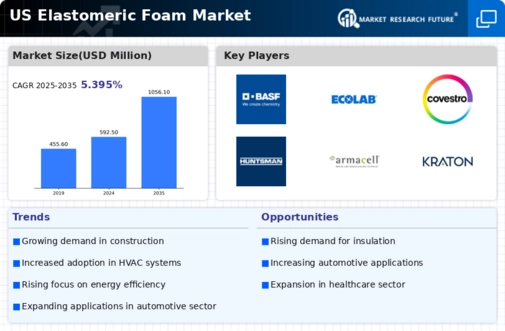The elastomeric foam market is characterized by a dynamic competitive landscape, driven by innovation, sustainability, and strategic partnerships. Key players such as BASF SE (DE), Huntsman Corporation (US), and Dow Inc. (US) are at the forefront, each adopting distinct strategies to enhance their market positioning. BASF SE (DE) emphasizes innovation in product development, focusing on sustainable materials that align with environmental regulations. Huntsman Corporation (US) has been actively pursuing mergers and acquisitions to expand its product portfolio and market reach, while Dow Inc. (US) is concentrating on digital transformation initiatives to optimize its operations and improve customer engagement. Collectively, these strategies contribute to a competitive environment that is increasingly focused on technological advancement and sustainability.
The market structure appears moderately fragmented, with several key players exerting influence over various segments. Companies are localizing manufacturing to reduce lead times and enhance supply chain efficiency. This tactic not only mitigates risks associated with The elastomeric foam market demands. The collective influence of these major players shapes the competitive dynamics, as they vie for market share through innovation and operational excellence.
In November 2025, Armacell International S.A. (LU) announced the launch of a new line of eco-friendly elastomeric foams designed for the construction industry. This strategic move underscores the company's commitment to sustainability and positions it to capture a growing segment of environmentally conscious consumers. By integrating recycled materials into its product offerings, Armacell aims to differentiate itself in a crowded market, potentially enhancing its competitive edge.
In October 2025, Rogers Corporation (US) expanded its manufacturing capabilities in the U.S. by investing in advanced production technologies for elastomeric foams. This investment is significant as it not only increases production capacity but also enhances the quality and performance of its products. The strategic focus on advanced manufacturing aligns with industry trends towards automation and efficiency, positioning Rogers to better meet the demands of its customers.
In September 2025, Sealed Air Corporation (US) entered into a strategic partnership with a leading technology firm to develop smart packaging solutions utilizing elastomeric foam. This collaboration aims to integrate IoT technology into packaging, enhancing functionality and providing real-time data to users. Such innovations reflect a broader trend towards digitalization in the industry, where companies are leveraging technology to create value-added products that meet evolving consumer needs.
As of December 2025, the competitive trends in the elastomeric foam market are increasingly defined by digitalization, sustainability, and the integration of advanced technologies such as AI. Strategic alliances are becoming more prevalent, enabling companies to pool resources and expertise to drive innovation. The shift from price-based competition to a focus on technological differentiation and supply chain reliability is evident. Moving forward, companies that prioritize innovation and sustainability are likely to gain a competitive advantage, shaping the future landscape of the elastomeric foam market.




















Leave a Comment